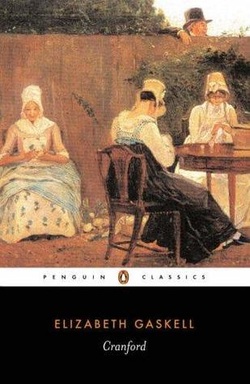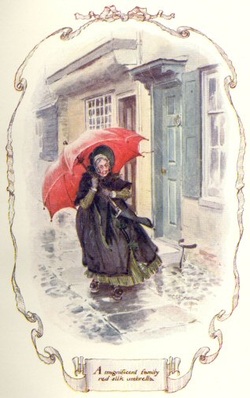
* * * *
Truly, I don’t know how I managed to have missed this author and this work over the years, in light of the many classics through which I’ve paged. Even so, I found the story to be a delightful journey into days of old.
Cranford tells of a group of women in the town of Cranford, who manage to hold court between and amongst themselves. No one wants to stand out even while each seeks to be the center of some attention! And so, we read: “although the ladies of Cranford know all each other’s proceedings, they are exceedingly indifferent to each other’s opinions.”
My favorite part about Cranford was that it was so funny! I’m not sure, if I had read Cranford back in the day when it was first published, that I would have thought the same. However, when looking back to days of yore, I find I imagine something exquisitely quaint about them—a certain je ne sais quoi that Gaskell in this work and with her humor, seems to have captured for all time. For example, consider: “Have you any red silk umbrellas in London? We had a tradition of the first that had ever been seen in Cranford, and the little boys mobbed it, and called it “a stick in petticoats.” (I love that!)
Truly, I don’t know how I managed to have missed this author and this work over the years, in light of the many classics through which I’ve paged. Even so, I found the story to be a delightful journey into days of old.
Cranford tells of a group of women in the town of Cranford, who manage to hold court between and amongst themselves. No one wants to stand out even while each seeks to be the center of some attention! And so, we read: “although the ladies of Cranford know all each other’s proceedings, they are exceedingly indifferent to each other’s opinions.”
My favorite part about Cranford was that it was so funny! I’m not sure, if I had read Cranford back in the day when it was first published, that I would have thought the same. However, when looking back to days of yore, I find I imagine something exquisitely quaint about them—a certain je ne sais quoi that Gaskell in this work and with her humor, seems to have captured for all time. For example, consider: “Have you any red silk umbrellas in London? We had a tradition of the first that had ever been seen in Cranford, and the little boys mobbed it, and called it “a stick in petticoats.” (I love that!)

For me, Cranford was one of those reads where the story was irrelevant. I didn’t care what happened or to whom nearly so much as I enjoyed the engaging word pictures, and the quirky personalities revealed along the way. Whether thinking it gauche to suggest one could—or couldn’t—afford something, or surmising as to the superiority of women in this little town with few men—even while coveting the attention of any man who happened by, or purporting that “it was time for Miss Jessie to leave off her dimples and not always to be trying to look like a child,” the word pictures just kept coming! Here is a favorite: “She sang, too, to an old cracked piano, which I think had been a spinet in its youth.” So, what difference does the story make when the words that create it are so colorful and thought provoking? For this reader—absolutely none.


